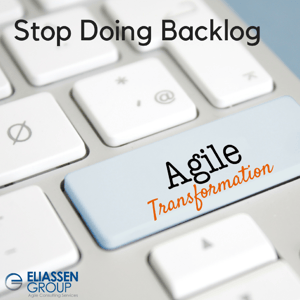In a recession, for most organizations the demand for products and services decreases. Organizations have fixed and variable costs and while variable costs might go down (e.g., the materials used to create the product), fixed costs don’t. Profitability, at best, decreases, and in the worse cases the company experiences a loss. Investing in Agile capabilities during an economic downturn would seem to be a bad idea. It adds costs (consulting, training, coaching) when less cash is available. And any time you make a change to your operating model it’s reasonable to expect some performance dip as people learn how to work in new ways. However, we assert investing in Agile capabilities during an economic downturn – or anticipated economic downturn – is a good strategy.
Agile approaches accelerate time-to-value, decrease waste, and enable more rapid and effective product innovation leading to new opportunities for economic growth. All of these are essential tools combatting challenging economic times. And investing in new capabilities will leave you in a better position to exploit opportunities when the cycle turns around. Let’s dig into these ideas in more detail.
Agile is an umbrella term for a variety of capabilities that enable organizations to be more responsive and effective in a dynamic and complex business environment. These include:
- Adaptive product portfolio investment planning and management that enables organizations to maximize the return on their product development investments
- Waste reduction and flow improvement that increase the speed and efficiency of value delivery
- Customer-centric approaches to product development that decrease risk and increase value
- Team-level planning and execution practices that enable responsiveness, quality, value, and engagement
- Cross-team coordination and planning that enable predictability in the face of uncertainty and change
- Technical and DevOps practices that decrease time to market, improve quality, improve engagement, and enable faster returns on investments
Looking at this list it is hard to imagine not wanting these capabilities during challenging economic times. You have less money to spend, and you need to maximize impact. That’s what these are about. However, wanting capabilities and being able to justify the expense and disruption are not the same. How and why would building your organization be something you would adopt as a strategic move during economic uncertainty?
Improve Your Likelihood of Economic Value Today
We have a few suggestions. First, focus on improving your capabilities in one or a very small number of areas that have the greatest potential immediate economic impact for your organization. Go narrow, not broad. You want the cost of building new capabilities to be paid for by the new value you deliver to the organization. For example:
- Launching a new product or enhancement to an existing product with high probability of increased revenue
- Decreasing significant operational costs through automation
- Increasing customer acquisition through an enhanced digital experience
Generally, we recommend innovation over cost reduction and minor product enhancements if you must choose. There is only so much cost you can remove from your operational budget, and your older products have limited room for growth. Real economic impact comes from finding the next opportunity to solve a critical customer need.
Identify key measurements that will enable you to know if your efforts are making an impact. Steering the organization in challenging economic times requires rigorous attention to data and quickly cutting losses when you aren’t making a meaningful economic progress and doubling down when you are.
Engage senior leaders in helping lead the change. While a mid-level manager might take a series of meetings over months to implement new ways of working, a leader setting clear direction can greatly decrease that time. Provide the leader with a team of influencers and change agents who can make things happen.
Engage expert consultants, Agile coaches, and people who know how to bring about DevOps culture, for example, to help. Find people who have experience in the areas of importance to you and a demonstrated record of making a difference. It is better to have a few great people.
Lay the Groundwork for the Future
When economic conditions turn around, what do you expect your customers will need? How can you prepare for those needs? If your competitors cut their product budgets, where can you invest to capture market share in the future and move ahead of them?
What capabilities, if implemented, will have you be more effective responding quickly and effectively in the uncertainty of a recovery? How do you become an adaptive organization that can both respond effectively in the face of uncertainty and rapidly adapt change ways of working when the old ways no longer serve your goals? While you can’t know the future, you can future-proof yourself to a degree by being prepared for whatever arises.
Economic uncertainty can also be an opportunity, if you are able to dig in, reflect, and invest.
If you are interested in learning more, read about Eliassen Group's Agile Consulting Services.



